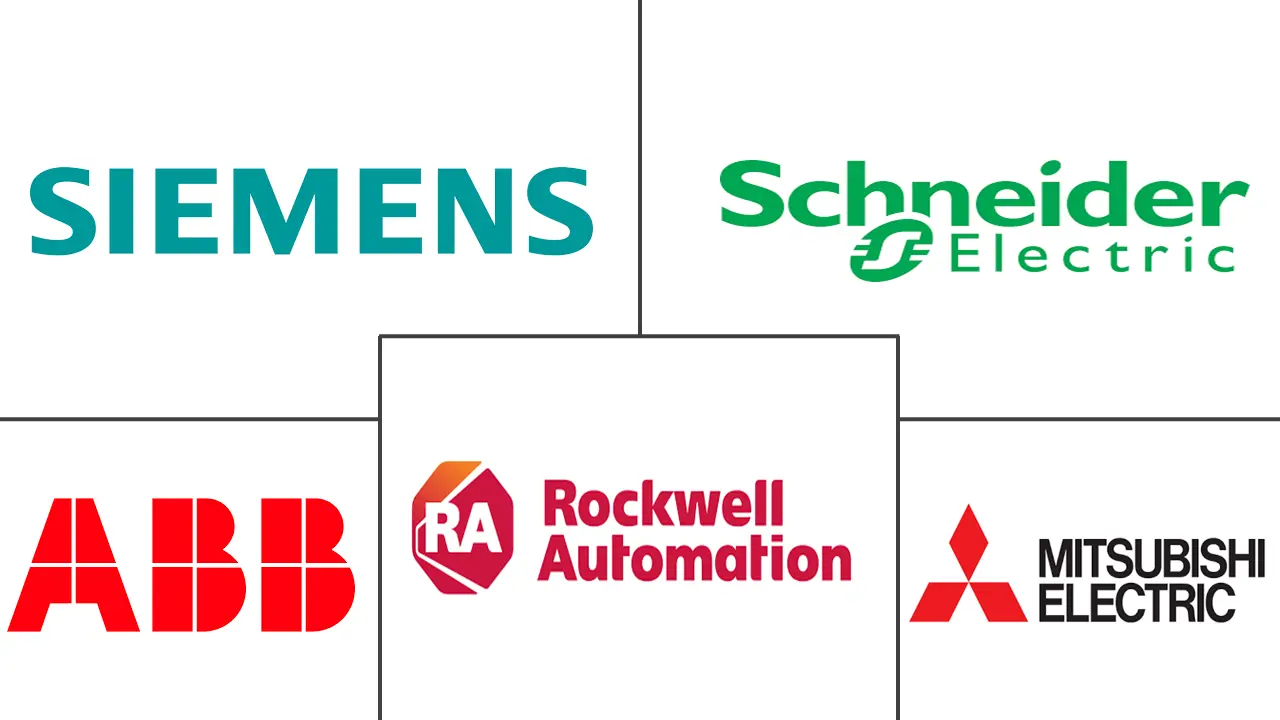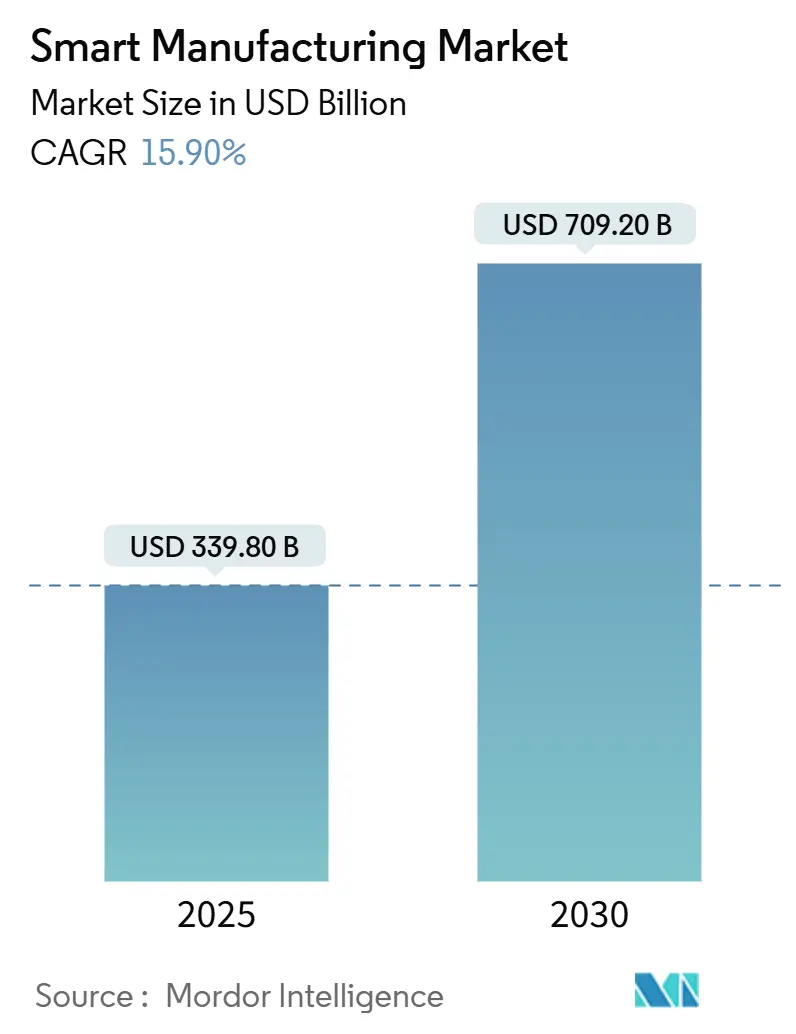
Smart Manufacturing Market Analysis by Mordor Intelligence
The smart manufacturing market size is valued at USD 339.80 billion in 2025 and is projected to climb to USD 709.20 billion by 2030, registering a 15.90% CAGR. Real-time analytics, machine connectivity, and AI-powered process control are converging to unlock large efficiency gains, while governments channel incentives toward resilient domestic production capacity. Rising energy costs and carbon-pricing schemes heighten interest in factory-level transparency solutions, and labor shortages intensify demand for collaborative robots and autonomous material-handling systems. Vendors are embedding private 5G and edge analytics in new offerings, enabling micro-second response times for safety-critical processes. Competitive focus is shifting from hardware refresh cycles to software subscription models that monetize predictive insights and energy optimization.
Key Report Takeaways
- By technology, Manufacturing Execution Systems led with 22.4% of smart manufacturing market share in 2024; digital-twin platforms post the fastest growth at 18.7% CAGR through 2030.
- By component, software accounted for 49.6% share of the smart manufacturing market size in 2024, while industrial robotics expands at 17.5% CAGR to 2030.
- By deployment mode, on-premise solutions held 64% revenue share in 2024; cloud deployments are projected to rise at a 19.2% CAGR between 2025-2030.
- By end-user industry, automotive captured 24% of smart manufacturing market share in 2024; aerospace & defense is advancing at a 16.8% CAGR through 2030.
- By geography, North America commanded 42.3% of 2024 revenue; Asia Pacific is forecast to grow at 15.9% CAGR to 2030.
Global Smart Manufacturing Market Trends and Insights
Drivers Impact Analysis
| Driver | (~) % Impact on CAGR Forecast | Geographic Relevance | Impact Timeline |
|---|---|---|---|
| Rising adoption of Industry 4.0 / IIoT for efficiency | +3.20% | Global, led by North America & Europe | Medium term (2-4 years) |
| Government incentives & policy mandates for digital factories | +2.80% | North America, EU, China, India | Short term (≤ 2 years) |
| Skilled-labour shortages accelerating automation uptake | +3.50% | North America, Western Europe, Japan | Short term (≤ 2 years) |
| Carbon Border Adjustment Mechanism spurring energy transparency | +1.90% | EU core, exporters worldwide | Medium term (2-4 years) |
| Digital-twin-based predictive-maintenance revenues | +2.10% | Global, high-value manufacturing hubs | Long term (≥ 4 years) |
| Roll-out of private 5G networks enabling ultra-low-latency control | +1.70% | APAC core, North America, select EU | Long term (≥ 4 years) |
| Source: Mordor Intelligence | |||
Rising adoption of Industry 4.0 / IIoT for efficiency
IIoT deployments now deliver 52% productivity gains and 25% cost reductions as factories integrate sensors, analytics, and cloud dashboards. The U.S. Manufacturing Extension Partnership supported 36,000 firms in 2024, adding USD 16.2 billion in sales through smart manufacturing programs.[1]National Institute of Standards and Technology, "Manufacturing Extension Partnership (MEP).", www.nist.govAs connected assets feed unified data lakes, operators can eliminate line stoppages and dynamically rebalance capacity. Precision-critical sectors such as aerospace embrace digital traceability to reduce scrap and warranty claims, fueling sustained upgrades in connectivity architectures.
Government incentives & policy mandates for digital factories
Federal and state-level funding initiatives are accelerating smart manufacturing adoption through targeted financial support and regulatory frameworks. The State Manufacturing Leadership Program offers USD 50 million to enhance manufacturing capacity through high-performance computing resources and technical assistance for small and medium manufacturers.[2]U.S. Department of Energy, "State Manufacturing Leadership Program." Accessed, www.energy.govGermany's Industrie 4.0 initiative projects EUR 40 billion annual investment by 2020, supported by Mittelstand 4.0 centers of excellence that provide SMEs with technology adoption guidance.
Skilled-labour shortages accelerating automation uptake
Manufacturing workforce gaps are compelling companies to implement automation solutions at unprecedented rates, with 70% of U.S. manufacturers affected by labor shortages and 49% planning AI implementation within two years.[3]Smart Industry. "Manufacturers cite widespread labor shortages, use of automation and AI to help.", www.smartindustry.com The sector faces a projected need for 3.8 million new workers by 2033, with 1.9 million positions potentially remaining unfilled due to skills gaps. Collaborative robots and autonomous mobile robots are increasingly deployed to perform repetitive tasks while human workers transition to higher-value roles requiring data analysis and system oversight.
Carbon-Border Adjustment Mechanism spurring factory-level energy transparency
The EU's Carbon Border Adjustment Mechanism implementation is driving manufacturers to integrate real-time emissions monitoring and energy transparency systems directly into production operations. Companies importing into the EU must collect embedded carbon emissions data and pay charges based on carbon pricing, compelling global manufacturers to digitize their energy management processes.[4]European Comission, "Carbon Border Adjustment Mechanism - European Commission", taxation-customs.ec.europa.euThe CBAM framework is establishing energy transparency as a competitive differentiator, particularly for manufacturers serving European markets where sustainability credentials directly influence purchasing decisions.
Restraints Impact Analysis
| Restraint | (~) % Impact on CAGR Forecast | Geographic Relevance | Impact Timeline |
|---|---|---|---|
| High CAPEX & uncertain SME ROI | -2.1% | Emerging markets most affected | Short term (≤ 2 years) |
| Cyber-security & data-sovereignty concerns | -1.8% | Global, regulated verticals | Medium term (2-4 years) |
| Legacy analogue equipment limiting interoperability | -1.5% | Heavy industries in mature regions | Long term (≥ 4 years) |
| Semiconductor supply-chain volatility delaying hardware | -1.2% | Electronics-dependent sectors | Short term (≤ 2 years) |
| Source: Mordor Intelligence | |||
High CAPEX & uncertain SME ROI
Small and medium enterprises face significant barriers to smart manufacturing adoption due to substantial upfront capital requirements and unclear return on investment timelines. Implementation costs for comprehensive smart manufacturing systems can range from hundreds of thousands to millions of dollars, creating financial strain for companies with limited resources. The complexity of calculating ROI for interconnected systems makes it difficult for SME decision-makers to justify investments, particularly when benefits may not materialize for 2-3 years.
Cyber-security / data-sovereignty concerns
The integration of operational technology with information technology networks creates new attack vectors that manufacturers struggle to secure effectively. Cybersecurity ranks as the top external challenge for 35% of APAC manufacturers, with cybercriminals targeting manufacturing companies in 46% of regional cyberattack incidents. Data sovereignty concerns are particularly acute in regulated industries where production data contains sensitive intellectual property or compliance-critical information. Companies are investing heavily in zero-trust security architectures and network segmentation strategies, but the complexity and cost of comprehensive cybersecurity measures continue to slow smart manufacturing adoption rates.
Segment Analysis
By Technology: MES Systems Drive Integration
Manufacturing Execution Systems held 22.4% of the smart manufacturing market in 2024, underscoring their role as the digital backbone of plant operations. The smart manufacturing market size for MES is projected to reach USD 41.78 billion by 2032 as manufacturers mandate real-time visibility across global plants. Digital-twin platforms, expanding at an 18.7% CAGR, let engineers simulate equipment behavior under varying loads, trimming commissioning times by 30% . PLCs and SCADA remain foundational, yet vendors embed AI modules that autonomously tune parameters. Edge-analytics software shortens decision loops for high-speed packaging lines, illustrating the shift from centralized servers to shop-floor micro-data centers.
Software-defined upgrades create sticky annual recurring revenue, prompting incumbents to bundle analytics with license renewals. Human-machine interface tools migrate toward augmented reality, giving line technicians guided workflows. Product lifecycle management solutions integrate with supply-chain portals so designers validate manufacturability early. Collectively, these innovations reinforce the smart manufacturing market as the primary conduit for continuous improvement investments.
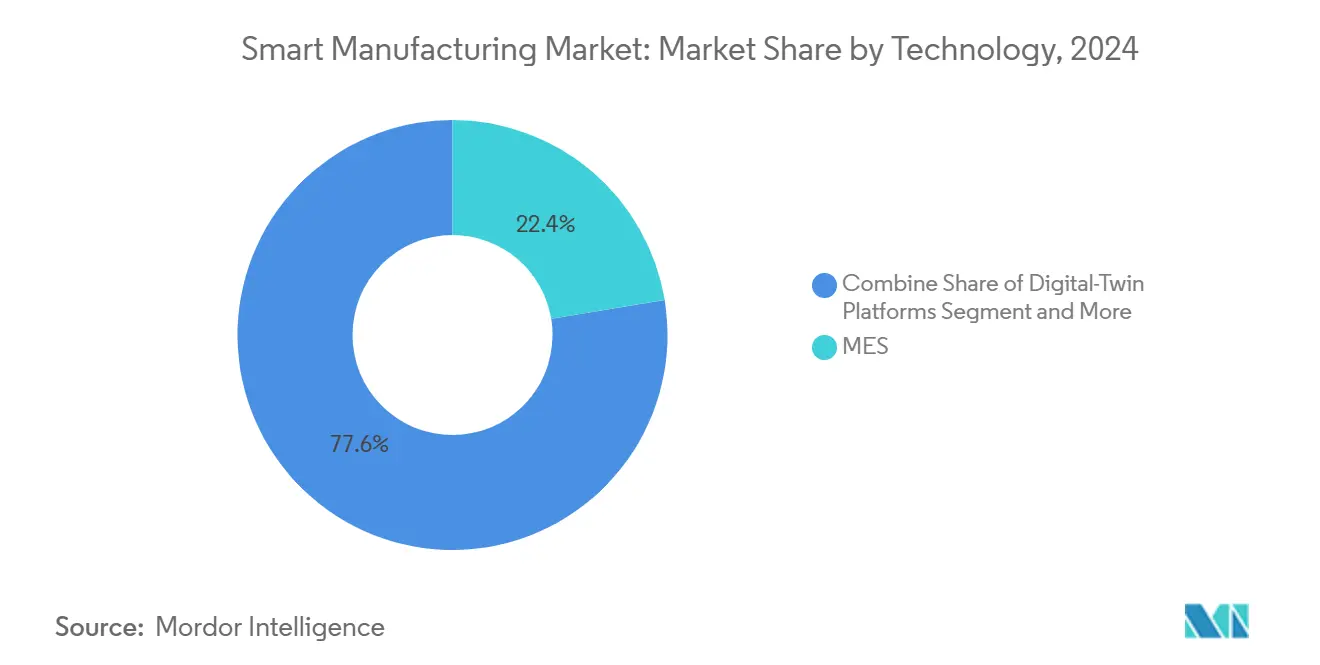
Note: Segment shares of all individual segments available upon report purchase
By Component: Software Dominance Amid Hardware Innovation
Software commanded 49.6% of 2024 revenue, reflecting the pivot toward data-driven workflows. Industrial robotics, projected to post a 17.5% CAGR, responds to chronic labor gaps and the need for flexible batch sizes.Smart sensors and machine-vision units feed high-resolution imagery to AI models that flag defects within milliseconds. Control devices now incorporate on-device inference engines, enabling autonomous adjustments without cloud latency. Service revenues expand as factories outsource integration, training, and managed cybersecurity.
Private 5G networks reshape the communication segment by supporting tens of thousands of end-points on a single floor with deterministic latency. Vendors co-develop spectrum strategies with telecom operators, turning connectivity into a strategic moat. As a result, the smart manufacturing market continues to blur lines between OT hardware and IT software, creating a unified platform for digital value creation.
By Deployment Mode: Cloud Momentum Challenges On-Premise Legacy
On-premise systems still command 64% share in 2024, favored for deterministic control and data sovereignty. Yet cloud subscriptions rise at 19.2% CAGR as CIOs prioritize scalability and faster software refresh cycles. Hybrid architectures that combine edge nodes with cloud analytics cut IT costs by up to 25% while delivering 20-30% productivity gains. Vendors now ship containerized MES modules that deploy across Kubernetes clusters in either environment, giving manufacturers phased migration paths.
Regulated industries such as pharmaceuticals adopt validated private clouds to maintain audit trails. Small and medium manufacturers embrace pay-as-you-go digital twins to avoid multimillion-dollar server upgrades. Consequently, the smart manufacturing market experiences a gradual rebalancing of deployment models, with capital-light strategies gaining traction.
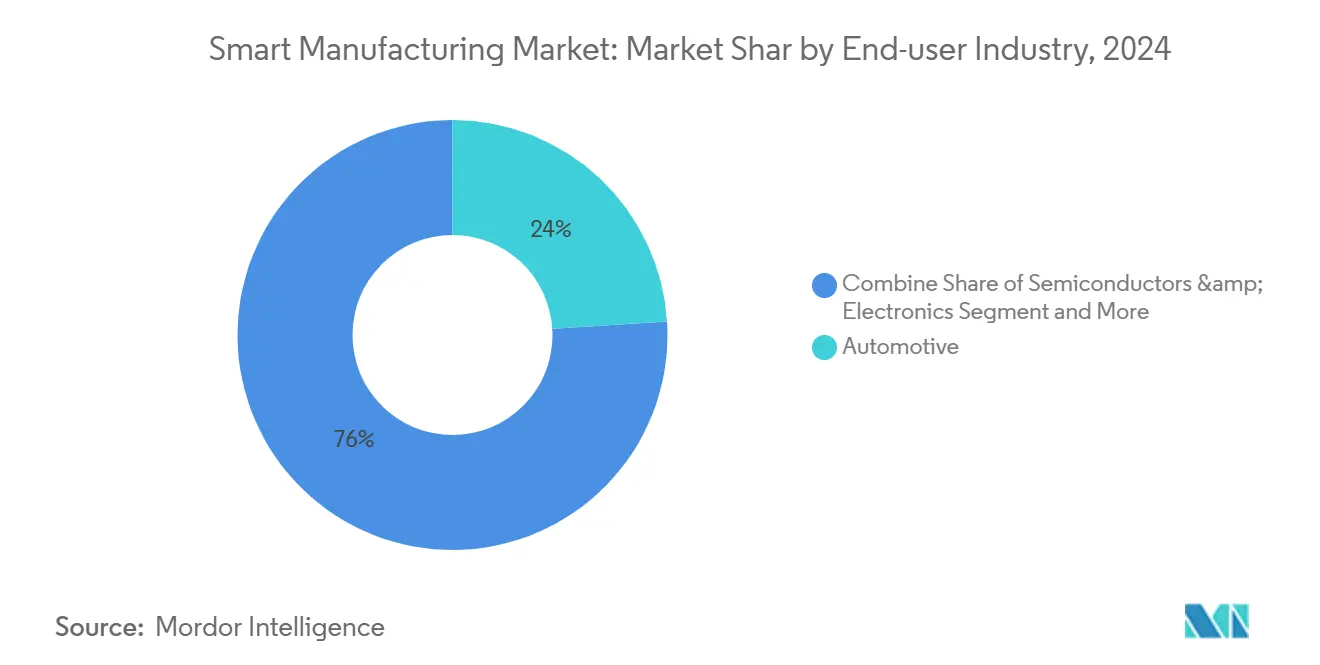
Note: Segment shares of all individual segments available upon report purchase
By End-user Industry: Automotive Leadership Faces Aerospace Challenge
Automotive maintained 24% revenue share in 2024, but only 14% of North American automakers currently run AI at scale, pointing to substantial headroom. Aerospace & defense, growing at 16.8% CAGR, leverages digital twins to certify complex systems faster and cut physical prototype costs by 40% . Semiconductor fabs deploy advanced process control to guard yield margins amid geometry shrinks. Oil & gas operators digitize pipelines with IoT sensors that detect corrosion in real time. Food & beverage plants automate palletization to offset seasonal labor swings while meeting stringent safety norms.
These patterns reveal the smart manufacturing market’s elastic demand across verticals, where ROI hinges on quality assurance, compliance, and responsiveness rather than simple labor substitution.
Geography Analysis
North America accounted for 42.3% of 2024 revenue, underpinned by the U.S. Department of Energy’s USD 33 million grant program and the Manufacturing Extension Partnership’s nationwide outreach . Venture capital flows accelerate technology diffusion, and private equity funds pursue platform roll-ups that bundle MES, robotics integration, and cybersecurity services. Regional suppliers adopt private 5G testbeds to validate latency-sensitive use cases such as remote welding.
Asia Pacific is the fastest-growing region with a 15.9% CAGR, propelled by China’s 33 Innovation Centers under the “Made in China 2025” banner and South Korea’s world-leading robot density of 1,012 units per 10,000 employees. India’s Digital Infrastructure Growth Initiative, backed by trilateral partners, lowers entry barriers for smart manufacturing startups, positioning the country as a rising hub for localized MES development.
Europe delivers steady adoption rooted in Germany’s Industrie 4.0, backed by EUR 40 billion (USD 44 billion) annual investment projections and Mittelstand 4.0 competence centers. The Carbon Border Adjustment Mechanism amplifies demand for energy-intensity dashboards, giving European vendors first-mover advantage in carbon accounting modules. Collectively, these dynamics reinforce regional specialization within the smart manufacturing market, shaping vendor go-to-market playbooks.
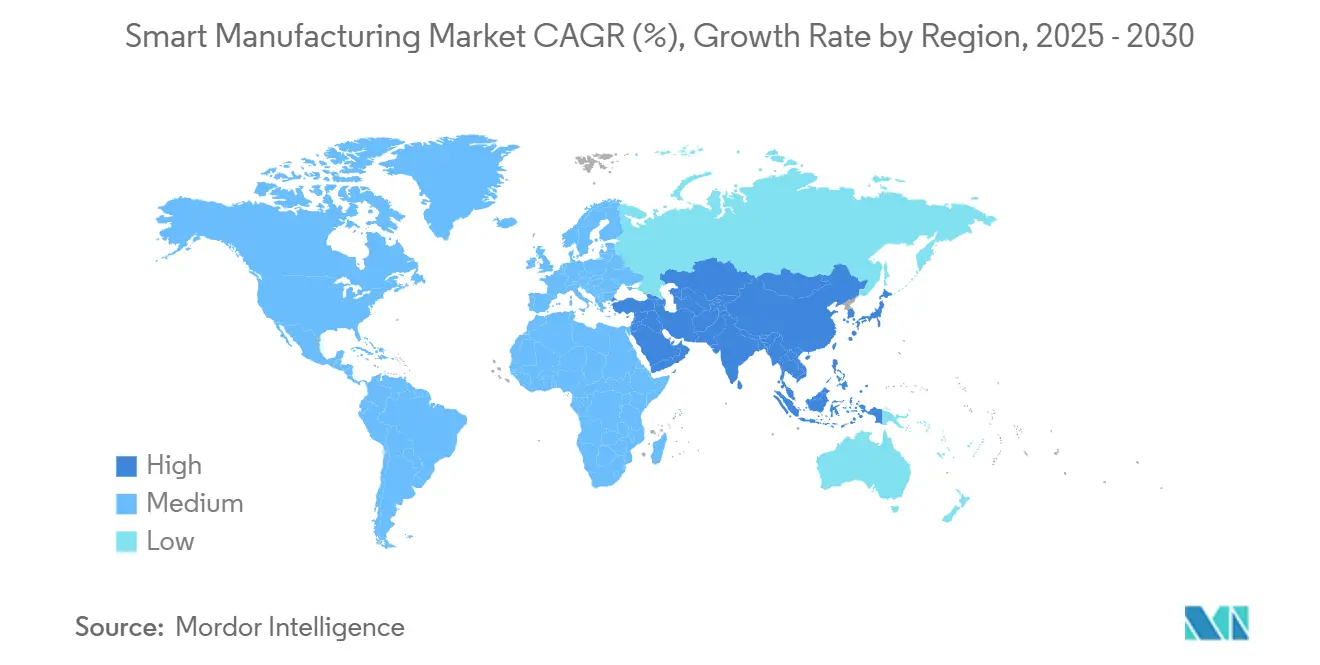
Note: Segment shares of all individual segments available upon report purchase
Competitive Landscape
The smart manufacturing market remains moderately fragmented. Incumbents pursue vertical integration in software to protect margins as hardware commoditizes. ABB’s pending robotics division spin-off will sharpen its focus on modular cell design and service contracts, while Siemens’ USD 5.1 billion move for Dotmatics advances life-science analytics capabilities. Emerging challengers build composable platforms that interoperate via low-code connectors, forcing legacy vendors to open APIs.
Strategic partnerships, such as CESMII and NIST’s alliance, foster pre-competitive standards that de-risk adoption for SMEs. Hardware players acquire AI startups to embed diagnostics at the edge, while cloud hyperscalers bundle manufacturing data lakes with integrated ML toolchains. M&A valuations prioritize data-rich product portfolios over installed base counts, signaling that ecosystem orchestration has supplanted pure scale as the primary source of competitive advantage.
Smart Manufacturing Industry Leaders
-
Siemens AG
-
Schneider Electric SE
-
Rockwell Automation Inc.
-
ABB Ltd
-
Mitsubishi Electric Corp.
- *Disclaimer: Major Players sorted in no particular order
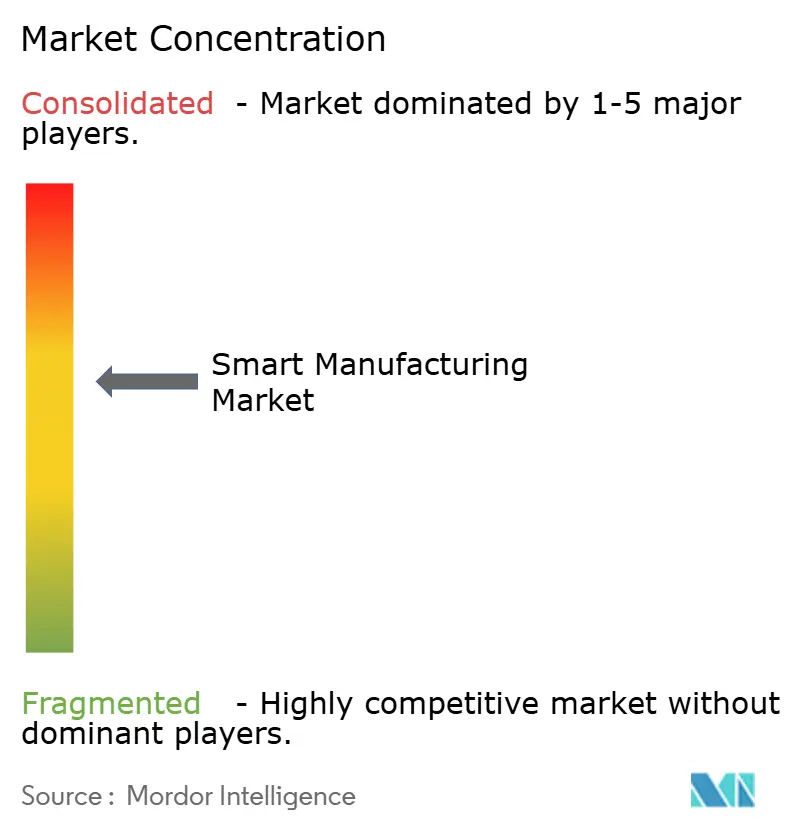
Recent Industry Developments
- May 2025: Siemens confirmed Altair integration and announced a USD 5.1 billion Dotmatics acquisition to deepen AI-driven digital-twin capabilities, signaling a pivot toward domain-specific software platforms.
- May 2025: ABB bought Siemens’ wiring-accessories unit in China, adding a USD 150 million revenue stream and expanding distribution across 230 cities to cross-sell factory automation hardware.
- April 2025: ABB revealed plans to spin off its USD 2.3 billion robotics business by 2026, aiming to unlock valuation multiples aligned with high-growth automation peers.
- March 2025: Micron committed USD 3 billion to its Manassas fab, embedding IoT analytics to boost yield and demonstrating how semiconductor makers anchor smart manufacturing investments in advanced data capture.
Research Methodology Framework and Report Scope
Market Definitions and Key Coverage
Smart manufacturing, as defined by Mordor Intelligence, spans all software, hardware, and connected services that enable real-time data exchange, self-optimizing production assets, and digitally driven decision loops inside factories and across supply chains. The estimate places the global market at USD 339.8 billion in 2025, rising to USD 709.2 billion by 2030.
Scope exclusion: ancillary IT outsourcing and generic enterprise software not deployed on the plant floor are left out.
Segmentation Overview
- By Technology
- Programmable Logic Controller (PLC)
- Supervisory Control and Data Acquisition (SCADA)
- Enterprise Resource Planning (ERP)
- Distributed Control System (DCS)
- HumanMachine Interface (HMI)
- Product Lifecycle Management (PLM)
- Manufacturing Execution System (MES)
- Digital-Twin Platforms
- Edge-Analytics Software
- Other Technologies
- By Component
- Hardware
- Robotics
- Sensors
- Machine-Vision Systems
- Control Devices
- Software
- MES
- PLM
- SCADA / ERP Suites
- Digital-Twin / AI and Analytics
- Services
- Integration and Implementation
- Consulting and Training
- Managed Services
- Communication Segment
- Hardware
- By Deployment Mode
- On-Premise
- Cloud
- Hybrid
- By End-user Industry
- Automotive
- Semiconductors and Electronics
- Oil and Gas
- Chemical and Petrochemical
- Pharmaceuticals and Life Sciences
- Aerospace and Defense
- Food and Beverage
- Metals and Mining
- Energy and Utilities
- Logistics and Warehousing
- Other Industries
- By Geography
- North America
- United States
- Canada
- Mexico
- South America
- Brazil
- Argentina
- Chile
- Rest of South America
- Europe
- Germany
- United Kingdom
- France
- Italy
- Spain
- Netherlands
- Russia
- Rest of Europe
- APAC
- China
- Japan
- India
- South Korea
- Australia and New Zealand
- ASEAN-5
- Rest of APAC
- Middle East and Africa
- Middle East
- Africa
- North America
Detailed Research Methodology and Data Validation
Primary Research
Interview rounds with plant managers, automation OEM product leads, systems integrators, and regional policymakers across North America, Europe, and Asia helped us stress test adoption rates, typical system prices, and retrofit timelines, thereby closing gaps left by desk research before final triangulation.
Desk Research
Our desk work begins with tier-1 public sources such as UN Comtrade shipment data, the International Federation of Robotics install base tables, U.S. Census ASM production statistics, Eurostat PRODCOM output series, and industry association white papers from MESA International and NAM. Annual reports, 10-Ks, and investor decks supply revenue splits, while patent analytics from Questel signal emerging technology diffusion. Complementary insights flow from paid repositories, D&B Hoovers for company financials and Dow Jones Factiva for curated news, to cross-check vendor performance, pricing moves, and capacity additions. This list is illustrative, not exhaustive; many other sources were consulted for data validation and clarification.
Market-Sizing & Forecasting
Model building uses a top-down production and trade reconstruction that scales factory value-add figures by digital penetration ratios, then corroborates results through selective bottom-up supplier roll-ups (sampled ASP × installed units). Key variables include industrial robot shipments, MES software license renewals, private 5G node deployments, and average retrofit CAPEX per square foot. Multivariate regression links these drivers to historic spend, while scenario analysis captures policy incentives and labor cost shocks. Where bottom-up estimates miss smaller geographies, regional proxies are applied and normalized to global totals.
Data Validation & Update Cycle
Every draft faces variance checks against external indices and prior editions. Findings pass a two-step peer review, and anomalies trigger follow-up calls. Reports refresh yearly, with interim updates when material events, such as subsidy rollouts or large M&A deals, shift baselines.
Why Mordor's Smart Manufacturing Baseline Commands Reliability
Published estimates often diverge because firms mix different technology baskets, price points, and update cadences.
Key gap drivers include inclusion of adjacent digital transformation services, differing ASP escalation paths, currency conversion dates, and refresh frequencies.
Benchmark comparison
| Market Size | Anonymized source | Primary gap driver |
|---|---|---|
| USD 339.8 B (2025) | Mordor Intelligence | - |
| USD 349.5 B (2024) | Global Publisher A | Adds IT consulting and cloud-only services, inflating base |
| USD 410.7 B (2025) | Industry Journal B | Uses list prices without regional discounting and counts aftermarket support |
| USD 263.2 B (2025) | Consultancy C | Hardware-centric scope ignores software subscriptions and integration fees |
These comparisons show that Mordor's disciplined scope selection, mixed top-down and bottom-up reconciliation, and annual refresh deliver a balanced, transparent baseline decision makers can rely on.
Key Questions Answered in the Report
What is the smart manufacturing market’s size and growth outlook to 2030?
The market stands at USD 339.8 billion in 2025 and is projected to reach USD 709.2 billion by 2030, expanding at a 15.9% CAGR.
Which technology segment shows the fastest expansion?
Digital-twin platforms lead growth with an 18.7% CAGR through 2030, reflecting rising demand for virtual commissioning and predictive maintenance.
Why are private 5G networks gaining traction on factory floors?
They deliver deterministic, ultra-low-latency connectivity that enables real-time robot coordination and safety-critical control applications impossible on Wi-Fi.
How do government incentives influence adoption?
Programs such as the U.S. Department of Energy’s grant initiatives and Germany’s Industrie 4.0 funding lower upfront costs and set technology standards that accelerate investment.
Page last updated on:
